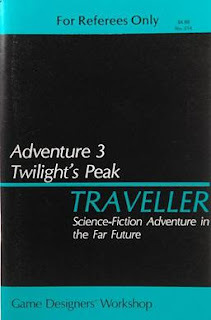James Maliszewski's Blog, page 25
March 17, 2025
REPOST: The Articles of Dragon: "The Nine Hells (Part I)"
 (The original post appeared here.)
(The original post appeared here.)And so we come, once again, to an excellent article written by Ed Greenwood – "The Nine Hells, Part I," which appeared in issue #75 (July 1983) of Dragon. In retrospect, it's easy to see why Greenwood would enjoy such success; he was not only prolific but also imaginative. Plus, his articles were memorable. Even now, nearly three decades later, I clearly remember the first time I read this issue of Dragon, filled as it was with information about the lower planes, thanks to both Gary Gygax's extensive preview of new devils from the upcoming Monster Manual II and the first part of Ed Greenwood's tour of the first five layers of AD&D's version of Hell. I was absolutely blown away by what I read, much to the chagrin of my players at the time, several of whom found themselves on unexpected visits to the domains of one or more arch-devils.
Like Roger E. Moore's "The Astral Plane," "The Nine Hells, Part I" is a work of remarkable scholarship, mining the entirety of the AD&D corpus available at the time for hints as to what the planes of Hell might be like. Also like "The Astral Plane," this article wasn't content to simply regurgitate what we already knew. Rather, it expanded on that information in clever and sometimes surprising ways, painting a picture of the Nine Hells that was both true to its gaming source material but also evocative of other works of fantasy and myth. Greenwood doesn't present his Nine Hells as canonical for anything other than his own Forgotten Realms campaign, but it wasn't long before it received Gygax's blessing, which gave it a status it enjoyed until comparatively recently, where books as recent as 2006's Fiendish Codex II: Tyrants of the Nine Hells continued to make use of ideas laid down in 1983. That's a degree of influence that few articles (or authors) can match.
In addition to giving names to each of the Nine Hells and discussing their locales and points of interest, Greenwood also devotes a fair bit of space to their inhabitants, in particular unique devils. Prior to this issue of Dragon, the arch-devils were the only unique devils described in AD&D. Now, both Gygax and Greenwood provided a coterie of such personalities, which, as a referee, I found a terrific boon. Unique devils gave me the opportunity to pit the PCs against powerful devils that weren't rulers of entire planes. This not only gave the PCs a fighting chance to defeat them but, in the event that the PCs did defeat them, the multiverse wouldn't resound with their victory the way it might if they bested Dispater or Geryon. Greenwood also found a way to work Astaroth from "The Politics of Hell" (from issue #28) into his depiction of the Nine Hells, which I know endeared him to many older gamers of my acquaintance who adored Alex von Thorn's article from way back when.
"The Nine Hells, Part I" (and its sequel, which I may well wind up discussing next time) are in a rare class of Dragon article: ones I actually used. Ever since I started playing AD&D, I desperately wanted to run adventures in the Outer Planes, but I rarely did, in large part because the game gave so little information on them. That's why articles like this and "The Astral Plane" were so useful and inspiring to me. And, unlike "The Astral Plane," Greenwood's Nine Hells articles were remarkably concrete, describing people and places one could encounter in addition to providing rules for how magic worked differently in this plane of ultimate Lawful Evil. I liked that a lot; I still do.
Musings on Poll Results (Part II)
With two more polls closed, let's take a look at the results, starting with when were you first introduced to roleplaying games? When I posted this poll on March 3, my initial guess was that most of my regular readers were introduced to tabletop RPGs sometime between 1979 and 1983. As you can see, my prediction was very close to the truth.

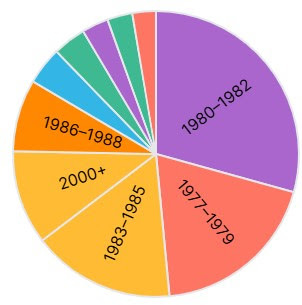 The period between 1980 and 1982, corresponding to the tail end of the Holmes Basic Set's run and the launch of Moldvay/Cook accounted for just shy of one-third of all votes, while 1977–1979 accounts for nearly one-fifth. Taken together, they represent almost one-half of respondents. Interestingly, the period between 1983 and 1985, during which the Mentzer's BECM boxed sets were released (I didn't appear until 1986) is a close third. Altogether, then, the nine-year period between 1977 and 1985 represents two-thirds of those who voted.
The period between 1980 and 1982, corresponding to the tail end of the Holmes Basic Set's run and the launch of Moldvay/Cook accounted for just shy of one-third of all votes, while 1977–1979 accounts for nearly one-fifth. Taken together, they represent almost one-half of respondents. Interestingly, the period between 1983 and 1985, during which the Mentzer's BECM boxed sets were released (I didn't appear until 1986) is a close third. Altogether, then, the nine-year period between 1977 and 1985 represents two-thirds of those who voted.The fourth place period of 2000+ is worthy of separate mention. Though only 10.66% of respondents chose this option, it's still larger than the other remaining options. This proves, I think, that Third Edition was a consequential edition of Dungeons & Dragons, one that introduced a lot of people into the hobby who have continued to participate in it. Though 3e is far from my favorite edition of the game, I also think it gets a much worse reputation in old school circles than it deserves. (As an aside, I think it's even more notable that the reign of 2e seems to have garnered so few votes, but perhaps that's just a quirk of my readership.)
The next poll, which originally appeared on March 10, asked: how old were you when you first started playing tabletop RPGs? My prediction was that the winning answer would be somewhere in the 10 to 14 age range – and I was correct.

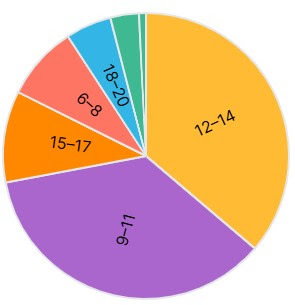 A little less than three-quarters of all correspondents chose either 9–11 or 12–14, with the latter winning by just two votes. This doesn't really surprise me. Most of the roleplayers I met in my youth were within a year or two of my own age – I started in late '79, having just turned 10. What does surprise me, though, is how much smaller than other age cohorts are, especially the 18–20 and 21+ categories, both of which are smaller than the 6–8 category. As ever, that may simply be a quirk of my readership, who largely seem to be middle-aged men who were born in the late '60s to early '70s. Even so, I remember older guys who roleplayed, like my friend's high school-aged older brother, for instance, and the college kids who hung around hobby shops. Where are they now?
A little less than three-quarters of all correspondents chose either 9–11 or 12–14, with the latter winning by just two votes. This doesn't really surprise me. Most of the roleplayers I met in my youth were within a year or two of my own age – I started in late '79, having just turned 10. What does surprise me, though, is how much smaller than other age cohorts are, especially the 18–20 and 21+ categories, both of which are smaller than the 6–8 category. As ever, that may simply be a quirk of my readership, who largely seem to be middle-aged men who were born in the late '60s to early '70s. Even so, I remember older guys who roleplayed, like my friend's high school-aged older brother, for instance, and the college kids who hung around hobby shops. Where are they now?
March 16, 2025
Was Your First Tabletop RPG Dungeons & Dragons?
March 14, 2025
Campaign Updates: Change of Course
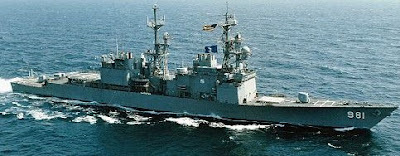
This was a week when all three campaigns shifted gears to varying degrees – in significant ways for both the Barrett's Raiders Twilight: 2000 campaign and the House of Worms Empire of the Petal Throne campaign.
Barrett's RaidersThis week, there wasn't much actual play. Instead, we devoted ourselves to tying up any loose ends in Europe, as the characters were about to head home aboard the assembled vessels of Task Force 34 (its flagship, USS John Hancock, depicted above). Chief among these loose ends was Private Ronnie Baxter of the British Army, who'd joined the characters in Kraków several weeks before. The British wouldn't be evacuating until the new year, so he bid the Americans farewell and rejoined his countrymen in Braunschweig, which served as the winter headquarters of the First British Corps. Several other player characters would also be departing upon arrival in Norfolk: Private Lou "Oddball" Guida (honorable discharge and returning home to Brooklyn); Seaman Jimmy "Aquaman" Jones (transfer to an actual naval unit), and Sergeant Jess "Cowpoke" Gartmann (other duties – the character of a player who dropped out of the campaign and stayed on as an NPC up till this point).
Much of the session was devoted to developing replacement characters for those departing, as well as the expenditure of experience points accumulated but not spent in previous sessions. I wanted to be sure that, when we resumed next week, everything was in place to pick up and play on the other side of the Atlantic. Lt. Col. Orlowski, the characters' commander, made a request to his superiors that his men be kept together for detached duties as needed in America. He argued that, having survived several months behind enemy lines in Poland, they'd formed a bond that would serve them and the Army well. This will form the new frame for the Barrett's Raiders campaign: the characters will be initially operating in Virginia and the surrounding areas during the period (December 2000–March 2001) when Naval Station Norfolk is still operational. After that, only time will tell.
DolmenwoodMarid Aventi having joined the party, the characters spent the day in Shagsend, conferring with Windore Hoblewort, a breggle magician who acts as Lord Malbleat's representative in the town. It was soon apparent that Hoblewort didn't think much of his master, but he was a great source of information about him and his activities nonetheless. For instance, Malbleat was presently preparing to host an annua festival called the Hlerribuck, said festival being a commemoration of the life and deeds of his illustrious ancestor, Wrygott Gnarlgruff. Since the characters were already interested in Gnarlgruff and his supposed involvement with the recent intrusion into Fairy, this news caught their attention. Surely this could not be a coincidence.
The group then said their farewells and made their way southward toward Redwraith Manor, the estate of Malbleat. They weren't head there: the Hlerribuck would be held at Shadholme Lodge, which sits atop the mausoleum where Gnarlgruff is interred. Still, they were fascinated to see that the way to the Manor was barred by a wrought-iron gate and further secured by heavy chains. Malbleat clearly didn't want unexpected guests to show up on his doorstep. They then continued on toward the festival grounds set up around the Shadholme, directed to the right place by a grumpy groundskeeper, who, like almost everyone in the High Wold, deferred to Falin, since she's a breggle (the High Wold being "breggle country"). Though this continues to make her uncomfortable – she's used to being ignored in human lands – her companions urge her to make the best of it as they prepare to mingle with the aristocracy and well-to-do of the region.
House of WormsToneshkéthu is a student at the Colllege at the End of Time, a institution that literally exists at the end of Tékumel's timeline – and not just one Tékumel but every possible version of Tékumel, of which there are many. She's been an ally of the characters for many years, though, because of the nature of her "location," they often encounter her out of temporal order. This makes dealing with her complicated, as she sometimes remembers things that, from the characters' perspective, haven't happened yet (and vice versa). She gave Keléno a device to communicate with her when necessary, but he's loath to use it. The other characters are not quite so reticent, which is why he contacted her at the end of the last session.
Keléno queried her first about the mind-bars placed on Nebússa and Kirktá. She brushed off the one placed on Nebússa, "It's just ordinary sorcery; you can deal with that yourselves." The one placed on Kirktá, she admitted was unusual and powerful. However, she cautioned against trying to remove it. "The mind-bar will come down on its own in time. Parts of it are probably already breaking down – or soon will be. It's there to protect him from things it can't yet handle. Removing it ahead of time would like shatter his mind." Keléno then asked about Prince Dhich'uné and his plans, specifically whether or not they should try to avoid involving themselves in them further. Toneshkéthu replied, "Oh, so you've reconciled yourselves to the fall of Tsolyánu, then? Interesting."
Needless to say, this horrified the characters. Were they supposed to aid Dhich'une, as Ki'éna suggested they would, or were they supposed to oppose him, as they preferred? They had no way of knowing, as Keléno declined to ask further questions of Toneshkéthu. He worried it might unduly influence their decisions one way or the other. He thanked her and bid her farewell. Before she severed communication, she told him to remember these words: The Inevitable of the Ineffable. The words meant nothing to him, but Kirktá immediately remembered reading a book of that title when he was younger. It was a polemic from Bednallján times, written by Artúkko Ala'á, a foe of the priest Pavár (whose divine revelation established the pantheons of Change and Stability). Ala'á argued that Pavár's religious reformation wold spell the end of the Bednallján imperium, as people abandoned the daily sacrifices to the One Other that sustained the empire.
What, if anything, this had to do with their present circumstances, the characters didn't yet know. They soon decided that the time had come to make Kirktá's existence known to the wider world. They would publicly announce his presence in Béy Sü and his status as an heir of the deceased emperor. By doing so, they hoped to draw out any who might be alarmed by his presence, including other heirs and factions vying for control during the interregnum. It was a dangerous gambit, of course, but they no longer wished to skulk around the edges of imperial politics. Now was the time to play their hand and see more clearly who their friends and enemies might be.
March 13, 2025
My Top 10 Favorite Traveller Images (Part II)
Part I can be found here.
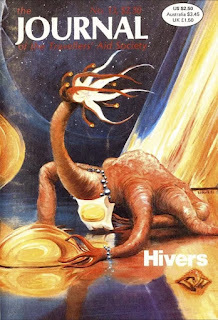
5. JTAS #13 Cover
The Journal of the Travellers' Aid Society was GDW's in-house periodical for supporting Traveller (until it was replaced by Challenge in 1986). With a few exceptions, the covers of JTAS weren't notable, but issue #13 is one that really captured my imagination. Drawn by William H. Keith, it depicts a member of the Hiver species, one of the most interesting – and weird – nonhuman aliens of the official Third Imperium setting. Few of the subsequent depictions of the Hivers ever looked as good as this one in my opinion, not even those in the Alien Module devoted to them. Consequently, this particular piece has stuck with me for years as a high point in Traveller art, particularly of alien species.
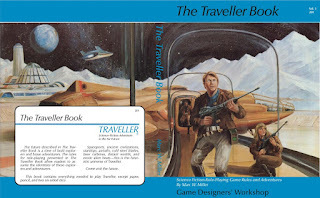 4. The Traveller Book Cover
4. The Traveller Book CoverWilliam H. Keith returns (for the last time) with his cover art for The Traveller Book. Its placement so high on this list is at least partially due to nostalgia, because I've used it as my go-to Traveller rulebook for decades. I readily acknowledge that, from a technical perspective, the cover is slightly amateurish. However, I care more about its grounded vibe. It's just a merchant crew warily disembarking their 200-ton Far Trader, armed and ready for anything. It's a terrific encapsulation of Traveller as a game and I love it, for all its weaknesses as a work of art.
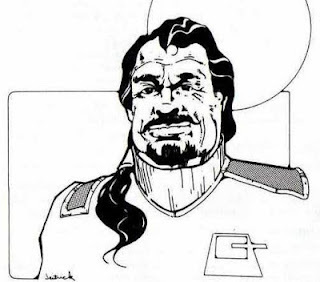 3. Alexander Lascelles Jamison
3. Alexander Lascelles Jamison
OD&D had Xylarthen the Magic-User and Traveller had Alexander Lascelles Jamison. This 38 year-old merchant captain has been the game's sample character since 1977, but his portrait got a significant upgrade in The Traveller Book over its original version. Drawn by David Dietrick, who provided a lot of great artwork for Traveller during the mid to late 1980s (and in Thousand Suns , too, come to think of it). Dietrick's reimagining of Jamison isn't just how I imagine this particular character; he's my mental image of the default Traveller character. You can't get much more iconic than that.
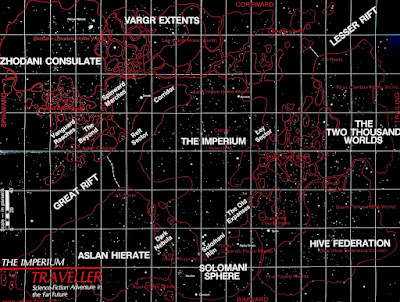 2. Charted Space Map
2. Charted Space Map
I've raved about my love of this map before, so I won't say much more here. I will add that this image is very near and dear to my heart, both because of what it depicts and how it depicts it. The map is peak classic Traveller – elegant and evocative with just enough information to inspire. I had this map pinned to my wall for years, so it will always be very special to me.
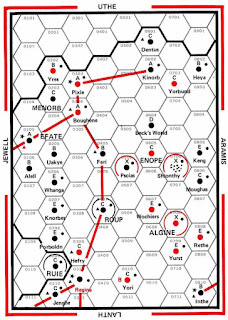
1. Regina Subsector Map
If D&D is defined in part by graph paper, Traveller is defined by hex paper, or rather by its 8×10 hex-based subsector maps, the foundations upon which the game's conception of the galaxy are built. Regina subsector is subsector C of the Spinward Marches and the example subector presented in in many GDW products. Regina is thus like the Grand Duchy of Karameikos, the Dalelands, or Lakefront City – an example that grows beyond its original purpose to have a life of its own. Every time I look at this map, I quickly find myself imagining situations and adventures on its worlds, especially those located outside the main travel routes. Looking at this map makes me want to play Traveller, which is exactly what a good RPG image should do.
Situation Report
1. SITUATION OVERVIEW
Virginia remains a highly contested region, with multiple factionsasserting control over key locations. USMEA-alignedforces maintain a presence at certain military installations but faceincreasing pressure from Free State militias, the unrecognized civilian authority (UCA) in Omaha, and lawless elements. The CIAnow actively supports the UCA, while the DIAfunctions as the primary intelligence agency for the USMEA.
Of particular concern are reports that some Free Statecommunities are rallying around a new movement known as “NewAmerica.” This ideology is gaining traction in multipleregions, with increasingly authoritarian rhetoric and signsof organized militarization.
2. FACTIONAL CONTROL(A) USMEA CONTROLLED AREAS
Naval Station Norfolk (Partial Control) – Severely damaged by a 1 MT nuclear blast but undergoing limited reconstruction. Remaining personnel scheduled for evacuation to Fort Dix by March 2001.
Fort Pickett – Largest intact USMEA installation in Virginia, serving as a hub for sustainment, logistics, and refit operations.
Fort Eustis – Hosting a reduced command staff. Limited aviation assets available, primarily for reconnaissance.
Fort Lee – Supporting logistical operations but vulnerable to disruption by external factions.
Defense Intelligence Agency (DIA) Operations – Now the primary intelligence service for USMEA forces, focused on counterinsurgency efforts against the Free State militias and intelligence gathering on the UCA.
(B) UCA CONTROLLED AREASNorthern Virginia Enclave (Reston, Falls Church, McLean) – Acts as a regional capital of the UCA, housing remnant federal officials, intelligence personnel, and security forces.
CIA Support – The CIA is actively supporting the UCA, providing intelligence and covert operations against USMEA and Free State-aligned factions. Reports indicate attempts to secure international recognition and foreign aid.
Raven Rock Mountain Complex (Site R) – Essential to the UCA's intelligence network, coordinating communication security and strategic analysis.
(C) FREE STATE-ALIGNED COMMUNITIESA loosely connected but growing resistance to both the USMEA and UCA. Most Free State settlements are self-sufficientagrarian enclaves or fortified urban districts, thoughrecent reports indicate some are becoming more militant.
Shenandoah Valley (Winchester, Harrisonburg, Staunton) – Independent militia strongholds, previously defensive in nature but now organizing in larger formations.
Southwest Virginia (Roanoke, Blacksburg, Bristol) – Mountain enclaves with deep anti-authoritarian traditions.
Richmond-Petersburg Corridor – While devastated, local councils have formed governance structures resistant to outside control.
(D) Emerging Threat: The “New America”MovementRumors suggest a faction within Free State territory is developing a new ideological framework calling itself “New America.”
Initially seen as an anti-USMEA and anti-UCA movement, recent intelligence suggests an increasingly rigid, authoritarian strain.
Reports from DIA field agents indicate organized military training, uniform insignias, and a structured chain of command within some Free State cells, particularly in the Shenandoah region.
“New America” rhetoric focuses on “reclaiming” the country, opposing foreign influence, and rejecting both USMEA and UCA as illegitimate.
Extent of their influence is unknown, but there are concerns about potential coordinated action.
3. THREAT ASSESSMENT(A) MILITARY THREATS
UCA Forces – Backed by CIA intelligence support, with well-trained but lightly equipped security teams.
Free State Militias – Formerly scattered, now showing signs of coordination. Some groups remain decentralized, while others align with New America.
New America Movement – Emerging as a wildcard. Unclear if their ultimate goal is regional control, larger-scale expansion, or simply survivalist militarism.
(B) ENVIRONMENTAL & INFRASTRUCTURE HAZARDSNuclear Damage: Arlington, Quantico, Fort A.P. Hill, Norfolk, and Portsmouth remain irradiated, with severe infrastructure loss.
Winter Weather: Severe cold, snow, and ice storms affecting travel and supply lines.
Fuel & Logistics Issues: Severe shortages of diesel and aviation fuel are restricting movement.
4. RECOMMENDATIONSSurveillance & Counterintelligence: Increased DIA operations needed to infiltrate and assess the true nature of the New America movement.
Fortify Key Installations: Hold Fort Pickett, Fort Lee, and Fort Eustis as strategic centers for USMEA operations.
Evacuate Norfolk Personnel: Expedite movement to Fort Dix before Free State militias or New America can disrupt transit.
Prepare for UCA Hostility: Anticipate covert CIA operations against USMEA forces.
END REPORTCLASSIFICATION: SECRET
DISTRIBUTION: USMEA Command, Fort Dix, Fort Pickett, Fort Eustis
March 12, 2025
My Top 10 Favorite Traveller Images (Part I)
Before I start, a couple of caveats and explanations. First, you'll note that I say "images," not "illustrations." That's because Traveller is rather (in)famous for its dearth of artwork, especially prior to the publication of The Traveller Book in 1982. However, the game never lacked for images, by which I mean maps, deck plans, and the like and many of these helped define the game and its approach to science fiction every bit as powerfully as did more "traditional" RPG illustrations. Second, I've purposefully limited my selection of images to Traveller products published by GDW between 1977 and 1986. There's a lot of third-party Traveller material published during that time, many with superb imagery, but, in the interests of focus, I've limited myself to only the main Traveller line. If there's sufficient interest, I might do a second series of posts that expands the scope a bit.
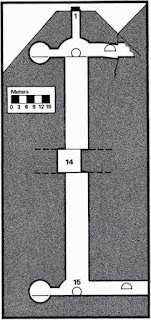
10. Diagram 1 from Shadows
Shadows is one of my favorite Traveller adventures, one I've refereed numerous times over the decades. One of my favorite things about the adventure are its maps and diagrams. All of them serve to describe the alien ruins found on the backwater planet of Yorbund that forms the location in which Shadows takes place. While several of them could easily have been chosen as an entry in this post, I think Diagram 1, pictured to the left, is by far the best and most interesting. As you can see, the diagram depicts the central shaft of the ruins, descending from a hidden entrance at the top of a surface pyramid tens of meters below the surface of Yorbund. It's a very practical image, enabling the referee to get a handle on how the various parts of the ruins relate to each other. It's also very atmospheric, establishing Shadows as a literal descent into the underworld.
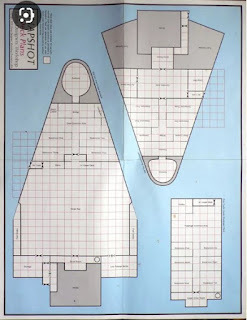 9. Snapshot Deck PlansAnother entry in this list and still no illustrations! Instead, gaze upon these deck plans from Snapshot. They depict two iconic starships from Traveller – the 100-ton Type S Scout/Courier and the 200-ton Beowulf-class Free Trader. These are probably the two most common "adventuring" starships in the game, in large part due to the fact that Scout and Merchant characters stand the chance of mustering out with one of them. They're also the perfect size for a band of characters. Though there are many other versions of these deck plans, it's these from Snapshot that are seared into my brain, thanks to having used them repeatedly in my youth.
9. Snapshot Deck PlansAnother entry in this list and still no illustrations! Instead, gaze upon these deck plans from Snapshot. They depict two iconic starships from Traveller – the 100-ton Type S Scout/Courier and the 200-ton Beowulf-class Free Trader. These are probably the two most common "adventuring" starships in the game, in large part due to the fact that Scout and Merchant characters stand the chance of mustering out with one of them. They're also the perfect size for a band of characters. Though there are many other versions of these deck plans, it's these from Snapshot that are seared into my brain, thanks to having used them repeatedly in my youth.
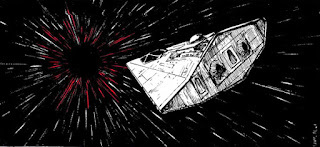 8. Entering Jumpspace
8. Entering JumpspaceOur first "proper" illustration and by William H. Keith, no less (a name that will appear several more times in this post and the next). In case the flash of red isn't enough to give it away, this piece appeared in The Traveller Book. That's the aforementioned Type S Scout/Courier as it prepares to enter jumpspace. Though very simple, it's a favorite of mine and has colored (no pun intended) my conception of what it Traveller interstellar travel looks like. Though I can't prove it, I suspect it was inspired, at least in part, by how the Millennium Falcon entered hyperspace in Star Wars.
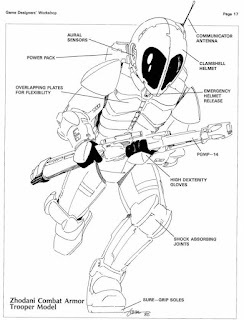 7. Zhodani Battle Dress
7. Zhodani Battle Dress
The psionic Zhodani are the main rivals of the Third Imperium and were described in detail in the fourth Alien Module produced for Traveller. One of many great things about that supplement is the way it firmly established the esthetics of the Zhodani Consulate and their citizens and military forces. I particularly like this illustration (by Bryan Gibson) of Zhodani battle dress, complete with notations pointing out its various features, such as its distinctive clamshell helmet. This piece occupies a halfway point between being a traditional illustration and being a diagram, I think, but it's all the more effective for it.
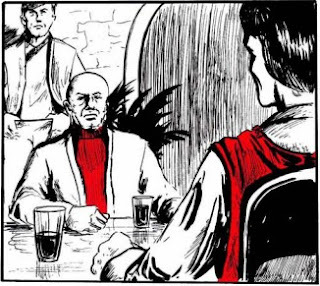 6. The Patron
6. The Patron
Another William H. Keith piece from The Traveller Book (note the red highlights), it depicts a distinctive element of Traveller – and one about which I'll be posting soon – the patron encounter. Many a Traveller adventure begins with meeting Space Sydney Greenstreet over drinks in the darkened corner of a startown bar, his bodyguard looming over the proceedings. Ironically, it's not a scene about which I can recall many illustrations in GDW products, which is probably why this one has stuck with me over the years. In many ways, this is the defining image of Traveller, or at least the way it was played back in my youth. If I didn't have other even more representative images, I'd probably rate this one even higher.
March 11, 2025
Retrospective: Twilight's Peak
First published in 1980, Twilight’s Peak is the third stand-alone adventure released for Traveller and one of the longest. At 64 pages, it surpasses both of its predecessors, The Kinunir and Research Station Gamma, by about 20 pages. Research Station Gamma in particular serves as something of an introduction to this adventure, both in terms of content and theme. Furthermore, because Twilight’s Peak was written by Traveller’s creator, Marc Miller, it holds particular significance for understanding his early vision of both the game itself and its official Third Imperium setting.
At its core, Twilight’s Peak is a treasure hunt in space, but one that leans heavily into the speculative and enigmatic side of science fiction. Unlike the mission-based structure of earlier Traveller adventures, which typically placed the characters in the service of a specific patron or mission objective, Twilight’s Peak assumes that the characters have a vested interest in the mystery itself, whether for profit, knowledge, or personal curiosity. This makes it one of the first Traveller adventures to fully embrace the potential of sandbox-style play in a science fiction setting.
Rather than offering a linear plot, the adventure provides a framework that encourages players to uncover clues from disparate sources: government records, old ship logs, academic research, and the accounts of independent traders, among others. This structure rewards careful and methodical play, allowing the characters to choose how they gather intelligence and when they advance the story. In contrast to other early Traveller modules, Twilight's Peak is not a "dungeon in space" but an investigative experience that unfolds gradually.
What makes Twilight’s Peak especially memorable is its connection to the Ancients, the long-extinct starfaring race whose relics and technology appear sporadically throughout the Third Imperium setting. While the adventure doesn’t explicitly spell out every connection, the discovery of a powerful and inexplicable alien base – complete with alien artifacts – forms its climax. This resonates with one of Traveller’s most important themes: the universe is vast and indifferent. While humanity (or humaniti, to use the game’s spelling) may rule an empire, it exists in the shadow of something immensely older and greater. This theme of humans as inheritors of a cosmos shaped by lost civilizations was a crucial part of Miller’s vision for Traveller. It aligns with the works of many classic sci-fi authors, such as Arthur C. Clarke, Larry Niven, H. Beam Piper, and Frederik Pohl, all of whom influenced Traveller to varying degrees. Later Traveller adventures would either downplay or over-explain the Ancients, but in Twilight’s Peak, they still retain a sense of mystery and grandeur.
Beyond its themes, Twilight’s Peak is an excellent sandbox adventure with just enough structure to guide players without forcing them down a predetermined path. The scenario is filled with red herrings, bureaucratic obstacles, and misinterpretations of historical data, making the information-gathering process more dynamic and engaging than a simple fetch quest. However, it also demands a lot from both the referee and the players. The adventure lacks an immediate action hook and takes time – a lot of time – to develop. Groups accustomed to more straightforward scenarios may struggle with its slower pace and its emphasis on research and deduction over direct confrontation.
For those who enjoy peeling back the layers of an ancient (or Ancient) mystery, however, Twilight’s Peak is among the most rewarding scenarios of Traveller's early years. As the third stand-alone adventure published for the game, it set the tone for much of what followed. Later Traveller adventures started to move away from ship-based conflict and small-scale tactical engagements, embracing exploration as an equally important, if not necessarily dominant, mode of play. Moreover, Twilight’s Peak helped cement Traveller’s reputation as a game of mystery and discovery rather than just interstellar heists and mercenary work. The best Traveller campaigns balance all of these elements, but Twilight’s Peak demonstrated that a non-combat, investigative adventure could be just as compelling as a military operation or corporate intrigue plot and, for that reason, among my personal favorite Traveller adventur.March 10, 2025
The Articles of Dragon: "The SF 'universe'"
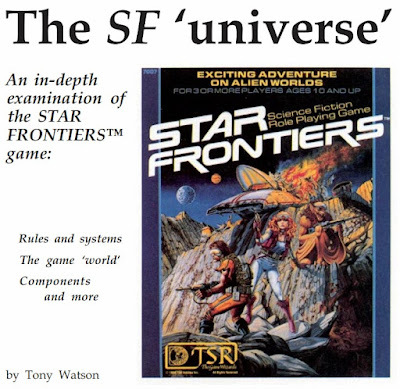 Anyone who's read this blog for any length of time knows that I'm a Traveller man. I first encountered GDW's game of science fiction adventure in the far future, sometimes in late 1981 or early '82 – my memories are hazy – and it very quickly became my go-to SF RPG. Heck, it still is today and this is despite the fact that I've written my own science fiction roleplaying game about which I remain proud. Traveller is nearly perfect in every way that matters to me, from the elegance of its rules to depth of its official setting. That a version of the game is still in print also means that it's easy to introduce new people to the game (though, to be fair, there are many other options available as well).
Anyone who's read this blog for any length of time knows that I'm a Traveller man. I first encountered GDW's game of science fiction adventure in the far future, sometimes in late 1981 or early '82 – my memories are hazy – and it very quickly became my go-to SF RPG. Heck, it still is today and this is despite the fact that I've written my own science fiction roleplaying game about which I remain proud. Traveller is nearly perfect in every way that matters to me, from the elegance of its rules to depth of its official setting. That a version of the game is still in print also means that it's easy to introduce new people to the game (though, to be fair, there are many other options available as well).Even so, as a diehard TSR fanboy in my youth, there was no way that I could pass up Star Frontiers when it was first published in 1982. Star Frontiers was no replacement for Traveller, but it was a fun game, one my friends and I enjoyed. In fact, I'm pretty sure many of my friends preferred it to Traveller, because of its more "wahoo!" approach to science fiction. That's not a knock against it by any means, just a statement of my own feeling that Star Frontiers has a much stronger action-adventure orientation than Traveller. If that's what you're looking for, Star Frontiers delivers.
Issue #74 of Dragon (June 1983) included a lengthy article, "The SF 'universe'" by Tony Watson that came to a similar conclusion. Over the course of seven pages, Watson presents an extensive review of the game, examining the setting, artwork, components, rules, and introductory module. The review is quite thorough and, I think, fair. Even though it appeared in the pages of Dragon, TSR's house magazine, Watson's review is not slavish in its praise. If anything, it errs a bit on the side of being occasionally too critical of the game and its decidedly different approach to science fiction than Traveller or Universe, to which Watson frequently compares Star Frontiers and not always positively.Watson's main criticisms of Star Frontiers are that it's strongly combat-focused, lacks starship rules, and that its overall tenor is more like Star Wars than 2001: A Space Odyssey. Of these criticisms, the lack of starship rules largely ceased to be an issue once the Knight Hawks expansion was released (ironically, not long after these article appeared). The other two criticisms are related, in my opinion. As I said earlier, Star Frontiers is more an action-adventure RPG than is Traveller. It's about adventures in space, fighting alien saboteurs and space pirates and surviving on a weird, inhospitable planet and the game's rules and presentation reflect that.
Watson understands this, which is why I appreciated this article when I first read it and still do. He does something I very much appreciate in reviews: he judges the success or failure of a game product on the basis of its intended goals rather than on what he might have wanted it to be. Star Frontiers wasn't trying to be Traveller or Universe but something else entirely and it deserves to be judged accordingly. It's a good standard and one I try to emulate (even if I don't always succeed).
James Maliszewski's Blog
- James Maliszewski's profile
- 3 followers


